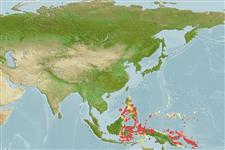>
Eupercaria/misc (Various families in series Eupercaria) >
Labridae (Wrasses) > Cheilininae
Etymology: Pseudocheilinops: Greek, pseudes = false + Greek, cheilos = lip + Greek, ops = appearance (Ref. 45335).
More on author: Schultz.
Environment: milieu / climate zone / depth range / distribution range
Ecologia
marino associati a barriera corallina; distribuzione batimetrica 5 - 15 m (Ref. 90102). Tropical; 19°N - 8°S
Western Central Pacific: southern Philippines and Celebes (Indonesia) to Palau.
Size / Peso / Age
Maturity: Lm ? range ? - ? cm
Max length : 6.5 cm TL maschio/sesso non determinato; (Ref. 48636)
Spine dorsali (totale): 9; Raggi dorsali molli (totale): 11; Spine anali 3; Raggi anali molli: 9
Mainly found in still coastal waters, where brittle corals grow high. Occurs in small groups that feed actively among the lower and dead parts of the corals with coralline algae. Easily overlooked because of its small size. Length to 6.5 cm, but usually much smaller (Ref. 48636). Always hides or stays close to its shelter (Ref. 90102). A secretive species. Feeds on amphipods and other small invertebrates. Rarely found in the aquarium trade.
Life cycle and mating behavior
Maturità | Riproduzione | Deposizione | Uova | Fecundity | Larve
Oviparous, distinct pairing during breeding (Ref. 205).
Westneat, M.W., 2001. Labridae. Wrasses, hogfishes, razorfishes, corises, tuskfishes. p. 3381-3467. In K.E. Carpenter and V. Niem (eds.) FAO species identification guide for fishery purposes. The living marine resources of the Western Central Pacific. Vol. 6. Bony fishes part 4 (Labridae to Latimeriidae), estuarine crocodiles. FAO, Rome. (Ref. 9823)
IUCN Red List Status (Ref. 130435)
Threat to humans
Harmless
Human uses
Pesca: di nessun interesse
Informazioni ulteriori
BibliografiaAcquacolturaProfilo di acquacolturaVarietàGeneticaElectrophoresesEreditarietàMalattieElaborazioneNutrientsMass conversion
CollaboratoriImmaginiStamps, Coins Misc.SuoniCiguateraVelocitàModalità di nuotoArea branchialeOtolithsCervelliVista
Strumenti
Special reports
Download XML
Fonti Internet
Estimates based on models
Preferred temperature (Ref.
123201): 28.5 - 29.4, mean 28.9 °C (based on 681 cells).
Phylogenetic diversity index (Ref.
82804): PD
50 = 1.0000 [Uniqueness, from 0.5 = low to 2.0 = high].
Bayesian length-weight: a=0.01585 (0.00707 - 0.03555), b=2.95 (2.76 - 3.14), in cm total length, based on LWR estimates for this (Sub)family-body shape (Ref.
93245).
Trophic level (Ref.
69278): 3.4 ±0.45 se; based on food items.
Resilienza (Ref.
120179): Alto, tempo minimo di raddoppiamento della popolazione meno di 15 mesi (Preliminary K or Fecundity.).
Fishing Vulnerability (Ref.
59153): Low vulnerability (10 of 100).
Nutrients (Ref.
124155): Calcium = 172 [97, 337] mg/100g; Iron = 1.04 [0.57, 2.01] mg/100g; Protein = 18.3 [15.4, 20.6] %; Omega3 = 0.166 [0.093, 0.292] g/100g; Selenium = 20.6 [10.4, 40.8] μg/100g; VitaminA = 165 [48, 681] μg/100g; Zinc = 2.5 [1.6, 4.0] mg/100g (wet weight);
